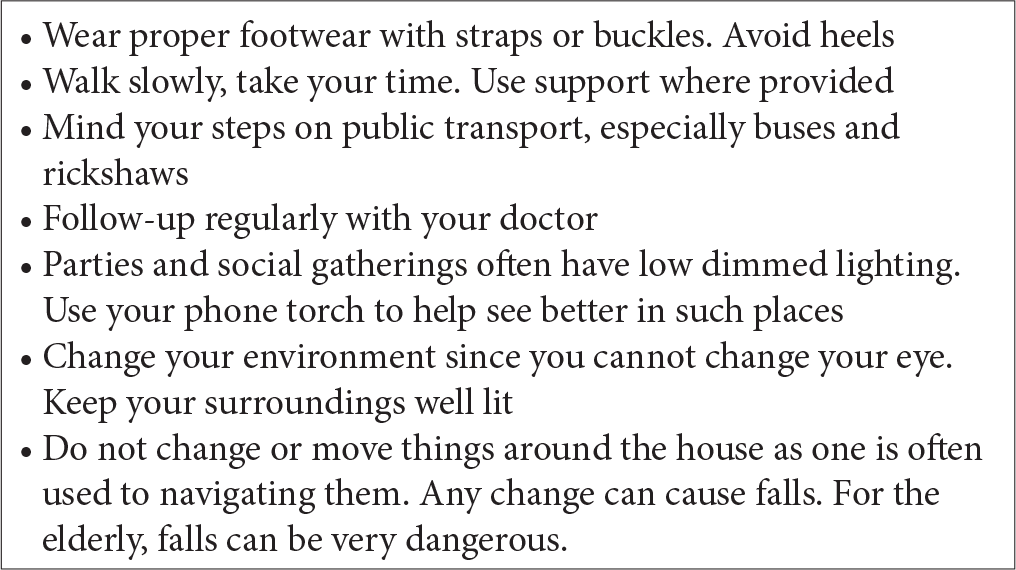Translate this page into:
Living smarter with glaucoma

*Corresponding author: Shital Patel, A 21, Shriram Industrial Estate, Wadala, Mumbai, Maharashtra, India. shital.patel@patientsengage.com
-
Received: ,
Accepted: ,
How to cite this article: Patel S, Mittal A, Senthil S. Living smarter with glaucoma. IHOPE J Ophthalmol 2023;2:25-7.
Dear Editor,
This editorial refers to the IHope webinar titled “Living Smarter with Glaucoma” aired on April 18, 2022, with panelists Dr. Sirisha Senthil, Head VST Glaucoma Centre, LV Prasad Eye Institute, patient advocate Ms. Viji Ventakesh, and moderator Aparna Mittal, founder of PatientsEngage (https://www.patientsengage.com/news-and-views/webinar-living-smarter-glaucoma).
In the webinar, the paucity of awareness and education on glaucoma was emphasized. The panelists highlighted that many people do not understand this disease or know about it. The patient advocate too underlined the benefits of sharing and talking about the issues which reduce the negative impact of the condition and help us learn from each other.
Glaucoma is a condition where there is irreversible damage to the optic nerve (the nerve that connects the eye to the brain), most likely due to elevated intraocular pressure. Optic nerve is the most sensitive and important for vision as it transmits nerve impulses to the brain. Unfortunately, this condition is asymptomatic, the loss of vision starts from the peripheral field, hence, is not obvious to the patient until advanced stage. One of the most effective ways to prevent irreversible blindness from glaucoma is to create awareness and detect the condition early. However, delayed diagnosis is a huge burden in our country. In the west, undiagnosed glaucoma is seen in close to 50% of the population, whereas in India, it is seen in over 90% as per the survey done by the LV Prasad Eye Institute and the Chennai Glaucoma study.[1,2]
The key to early detection is regular screening, especially for person with comorbidities such as diabetes, hypertension, and age above 40 years. General advice is to see an ophthalmologist when presbyopia sets in post 40 years of age and every 2 years henceforth. The test should be comprehensive with evaluation of the intraocular pressure, gonioscopy, and optic nerve. A complete eye evaluation requires 1–2 h where there is check-up of the front of the eye pre dilatation and the back of the eye post-dilatation. Without dilatation, the optic nerve and retina can only be partly evaluated and glaucoma can be easily missed in the check-ups without dilatation. People who have a family history should test earlier depending on the type of glaucoma in the family. There is no fixed age so as a rule, check-up at the time of onset of presbyopia is a good opportunity. Patients with a family history of angle-closure glaucoma would benefit from early screening (earlier than 35 years of age) as angle closure may occur at an earlier age.
RISK FACTORS FOR GLAUCOMA WERE DISCUSSED AND ARE LISTED BELOW
Positive family history
High myopia or short-sightedness is a condition linked to glaucoma, especially open-angled glaucoma
History of trauma to the eye or any prior intraocular surgery done at a young age
Indiscriminate use of steroid drops and/or ointments on the face. Studies show that in India, the most common type of secondary glaucoma in children is steroid-induced glaucoma. In a recent publication from a southern state of India, 43% of the eyes were blind at presentation due to steroid-induced glaucoma, and majority were children.[3] This is primarily due to abuse of steroid drops for allergies, face ointments for dark spots, and fairness creams (which often contain steroids not mentioned on the product). Use for even a short period of time such as a month or two can increase one’s risk of glaucoma, sometimes even with low potent steroid.
Steroids when indicated and used appropriately as advised by the treating physician and monitored regularly have benefits. Systemic steroids taken orally have minimal effects on the intraocular pressure but can cause cataracts. Drops and ointments used in and around the eye cause a higher risk of glaucoma. Even when applied to lips for eczema, they can enter the blood circulation and cause damage to the eye. There is a term called steroid responsiveness, where some people are more susceptible to steroid side effects than others. About 18–20% of people on steroids can be steroid responders.
TREATMENT DEPENDS ON THE TYPE OF GLAUCOMA. GLAUCOMA IS OF TWO KINDS
Primary – which is due to no other preceding cause. Can be hereditary or due to malfunctioning of the drainage channels in the eye
Secondary – which is due to some other cause such as trauma, surgery, and steroid use.
There are open-angle and angle-closure glaucomas. For angle closure, laser peripheral iridotomy is required to remove the block and create fluid circulation pathway followed by medical treatment. For open angle, mainstream treatment is eye drops to decrease the eye pressure. The treatment for glaucoma is lifelong unless patients are operated on for it and their intraocular pressures are under control.
Dr. Sirisha tells us that for close to 80% of the people, eye drops are very effective to control the eye pressure. For the others, additional laser or surgical intervention may be needed. There are now multiple types of surgical interventions available. With new advances, procedures not only control the eye pressures but also offer better safety. Compliance with medications is very important and needed for this disease. Patients are advised not to discontinue or experiment with their eye drops without the consent of their doctor.
There are many medications available for glaucoma. One group of medicines is called prostaglandin analogs, which are the most common and most effective. The choice of class of medication depends on several factors from efficacy, affordability, tolerability, and side effect profile.
If pressures go untreated or uncontrolled, it can cause venous occlusion affecting the eye and leading to sudden loss of vision. Best way to prevent complications is to have the intraocular pressure under control. Pressures do fluctuate from time to time and can also depend on one’s hormones and metabolism. In general, pressures peak in early morning. Some medications are prescribed at night because the peak effect of the drop is between 4 and 5 h after application, so this prevents that early morning peak in pressure. Some meds are given at night as they cause redness in the eye. Some meds are given in the morning because they do not work well at night when the body’s baseline blood pressure is low. Hence, the medication is prescribed keeping in mind the mechanism of action and peak effect times of the drug.
Some studies show that yoga and meditation can help decrease the intraocular pressure, possibly by increasing the outflow of fluid.[4] It also helps to decrease stress and improve quality of life. Stress and worry can worsen glaucoma due to increase in cortisol levels. However, one must not skip or stop their medications while trying alternative therapies. Be careful with weight-lifting exercises, especially after glaucoma surgery. Essentially, any exertion that raises the abdominal and thoracic pressure such as coughing, straining while passing stool, and weightlifting should be avoided. Ms. Viji points out that her doctor specifically told her to stop doing kapalbharti breathing as it is harmful to glaucoma.
Overall, this webinar provides key answers to the burgeoning questions on this chronic eye disease that lacks the essential awareness and education necessary for early detection strategies. The take home message is clear and precise in that prevention through regulated screening is the sole key method to avoid late diagnosis and loss of vision. In addition, it provides us with novel information on patient’s perspective with early signs of the disease, missed diagnostic opportunities, and living conditions post-diagnosis [Image 1].

- Tips for lifestyle changes
Declaration of the patient consent
The authors certify that they have obtained all appropriate patient consent.
Conflicts of interest
There are no conflicts of interest.
Financial support and sponsorship
Nil.
References
- Prevalence of primary angle-closure disease in an urban south Indian population and comparison with a rural population. The Chennai glaucoma study. Ophthalmology. 2008;115:655-60.
- [CrossRef] [PubMed] [Google Scholar]
- Prevalence and risk factors for primary glaucomas in adult urban and rural populations in the Andhra Pradesh eye disease study. Ophthalmology. 2010;117:1352-9.
- [CrossRef] [PubMed] [Google Scholar]
- Steroid-induced glaucoma and blindness in vernal keratoconjunctivitis. Br J Ophthalmol. 2020;104:265-9.
- [CrossRef] [PubMed] [Google Scholar]
- Effect of yoga-based ocular exercises in lowering of intraocular pressure in glaucoma patients: An affirmative proposition. Int J Yoga. 2018;11:239-41.
- [CrossRef] [PubMed] [Google Scholar]





